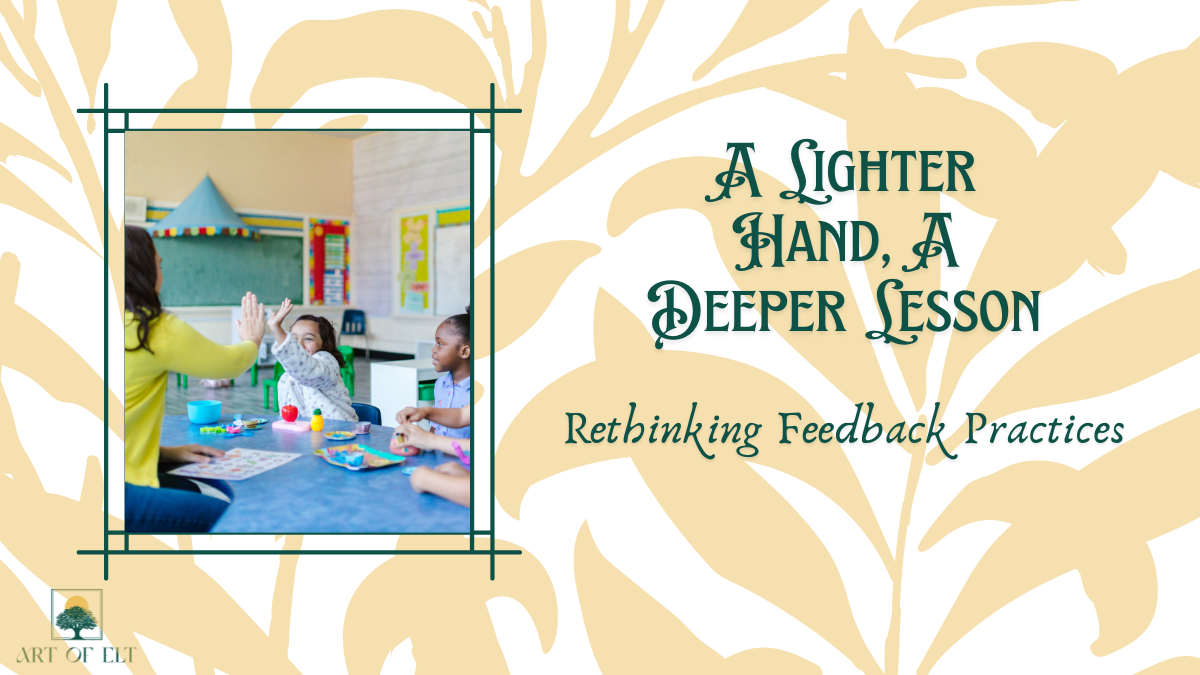A Lighter Hand, A Deeper Lesson

Rethinking Feedback Practices
Introduction
I remember how I used to work on feedback years ago: it was often midnight, and I, an experienced language teacher, was still hunched over a pile of homework and student texts. My eyes blurred as I corrected yet another misused preposition. Sure, I had promised herself I’d go to bed earlier, but once again, marking had taken over my whole evening.
Sound familiar?
Many teachers pour hours into marking, believing that meticulous correction equals effective feedback. But research—and lived experience—suggests otherwise. If we want students to actually improve and not just see their mistakes, maybe it’s time to rethink how we give feedback. The question is: Is all this marking really necessary?
The short answer, which I expand on in this blog post is: Nope. Not for the students, and not for use teachers.
What Research Says About Feedback
There’s a common assumption that the more feedback we give, the better students learn. But studies in education and psychology suggest that this isn't always the case. John Hattie’s (2008) research on feedback effectiveness highlights that how feedback is given matters more than how much.
Effective feedback isn’t about drowning students in corrections; it’s about guiding them toward improvement. A few key insights from research include:
- Feedback should be timely. A comment made weeks after a student’s work is completed has far less impact than a discussion in the moment.
- Feedback should be focused. Addressing one or two key areas at a time helps students process and apply what they’ve learned.
- Feedback should be actionable. If students don’t know what to do with it, it’s just red ink on a page.
Instead of marking every single grammar mistake, what if we aligned feedback with learning goals? For example, if a lesson focused on writing topic sentences, feedback should focus on just that—not on commas, verb forms, and every other issue in the text.
Alternative Feedback Methods
If exhaustive marking isn’t the key to learning, what are the alternatives?
1. Peer Feedback and Self-Assessment
One of the most underused feedback strategies is getting students to review each other’s work. Not only does this lighten a teacher’s marking load, but it also teaches students to think critically about language.
- Peer Feedback: With clear guidance (e.g., checklists or rubrics), students can give each other valuable insights. They often notice issues in a classmate’s writing that they don’t recognize in their own.
- Self-Assessment: When students review their own work before submission, they start internalizing learning goals. Instead of just seeing corrections, they learn to spot and fix mistakes independently.
A small shift—such as having students highlight areas they’re unsure about before submitting their work—can make a big difference. It helps teachers target feedback efficiently, focusing on what students actually need help with.
2. Verbal Feedback
Feedback doesn’t always have to be written. In fact, verbal feedback is often more effective because it allows for immediate clarification and discussion.
Consider:
- In-class feedback: While students are working, walk around and comment on their writing in real time.
- Conferencing: A quick one-on-one chat about a student’s work can often be more impactful than extensive written comments.
- Whole-class feedback: Instead of marking 30 essays in detail, identify common errors and address them with the whole class.
This method aligns with the Acceptance and Commitment Therapy (ACT) principle of psychological flexibility—focusing energy where it makes the most impact instead of rigidly sticking to exhaustive marking.
3. Marking Selectively
Not every assignment needs to be marked in full. Teachers can reduce marking by:
- Focusing on a single aspect (e.g., organization, argument strength, vocabulary use).
- Using symbols instead of corrections (e.g., underlining an error instead of fixing it, prompting students to figure it out).
- Grading only a portion of longer assignments (e.g., giving full feedback on the first page only).
This shift isn’t about “doing less” but about making marking more meaningful for both students and teachers.
Benefits of Rethinking Marking
By marking less and providing smarter feedback, teachers can:
- Reduce stress. Endless evenings of marking don’t necessarily translate into better learning. A more efficient approach frees up time for planning engaging lessons—or just having a life outside of work.
- Avoid overwhelming students. A paper covered in corrections can feel discouraging. Selective feedback helps students focus on progress rather than mistakes.
- Improve learning outcomes. When feedback is immediate, focused, and actionable, students engage with it more and make meaningful improvements.
A case in point: When a group of language teachers trialed replacing traditional essay marking with verbal conferences, they found that students rewrote their work with greater accuracy and actually remembered the feedback in future assignments (Nguyen, 2020).
Conclusion
It’s time to shift the focus from marking more to teaching more.
Instead of overwhelming yourself (and your students) with corrections, consider experimenting with just one new approach in your next marking session:
*** Try giving verbal feedback instead of written comments.
*** Have students highlight the areas they want feedback on.
*** Provide whole-class feedback rather than marking everything individually.
Small changes can have a big impact—not just on student learning, but on teacher wellbeing too.
So, what marking habit are you ready to rethink? How can you make feedback more effective, manageable, and human?
Sources:
Hattie, J. (2008). Visible learning: A synthesis of over 800 meta-analyses relating to achievement. Routledge.
Nguyen, T. T. T. (2020). Does conferencing feedback improve non-English majors' paragraph-writing? International Journal of Innovation, Creativity and Change, 14(3), 1-18. https://www.researchgate.net/publication/347866822
Categories: : teacher wellbeing, teaching systems, time management, feedback
 Ana Jereb
Ana Jereb 